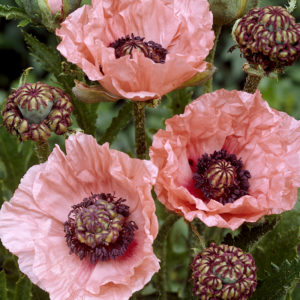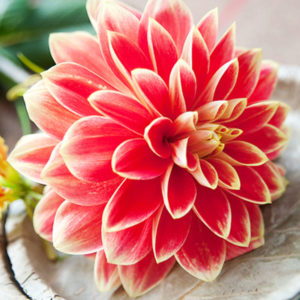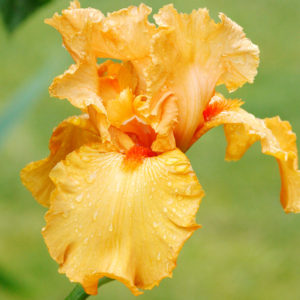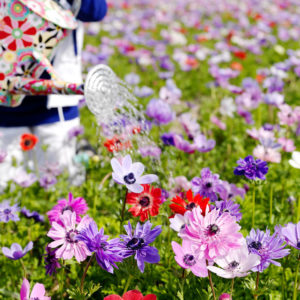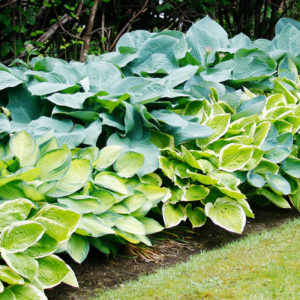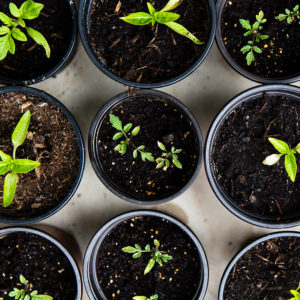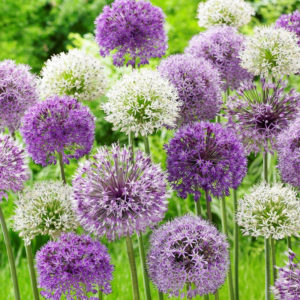June is here and summer temperatures are underway for most gardeners. The gardening season doesn’t stop for most gardeners, but it can slow down along with the higher temperatures of mid-summer. For those of us who enjoy spending our days digging in the dirt and immersed in foliage, you may have some late spring garden questions. We are happy to provide answers to those questions!
My Poppies were blooming and beautiful just a few weeks ago and now they have disappeared. What happened to them?
Oriental Poppies bloom in late spring, usually sometime between May and June depending on where you are located and your local temperatures. When poppies are done blooming they will go into dormancy, or as I like to say (and do) they take a nap!
During their dormant period, they lose their foliage and essentially disappear from your garden. Your oriental poppies may put on some green growth towards the end of summer into early fall, but for the most part, they will be non-existent during the summer months. If you have oriental poppies planted in your garden it is a good idea to add some summer blooming perennials around where they are planted to fill the void that is left when they go dormant.
Can I still plant summer blooming bulbs in late spring or early summer?
While it is certainly ideal to plant summer-blooming bulbs such as gladiolus, dahlias, caladium, and begonias earlier in spring. Early season planting provides a longer growing season. However, that is not always necessary and these bulbs can still be planted in the early parts of summer.
Gardeners in colder climates may prefer to wait until late June and early July to plant as their soil and air temperatures will be warmer at that time and the bulbs will have the best conditions for quick growth.
Gardeners in warm to moderate climates, such as zones 6, 7, and 8 can also still plant summer blooming bulbs late in the season. As temperatures rise it is important to monitor the flower bulbs’ water intake closely once sprouts have formed.
For bulbs such as caladium, planting late in the season can have huge benefits as they are prone to rotting if they are planted in soil that is too cold. I have had great success planting caladium, dahlias, begonias, and calla lilies in late June to early July. In those instances, I have had to wait a little longer to see blooms. However, would be able to enjoy the blooms in my garden from late July through September.
I don’t know what happened, but my Bearded Iris did not produce flowers this year! Why would my Bearded Iris not bloom?
Bearded Iris is a popular late spring to early summer blooming flower bulb. Siberian iris bloom this time of year as well. Both bearded iris and Siberian iris are in the iris family of plants but have some subtle differences.
Bearded Iris grow from rhizomes, are available in nearly every color of the rainbow, have large blooms that have a beard on the petals, and wide 1-2″ wide leaves.
Siberian Iris has thin grass-like leaves, grow from a root, and are available in mainly purple, blues, whites, yellows, and pink. Both Siberian iris and bearded iris may stop blooming over the course of several years, so this information will apply to both bearded iris and Siberian iris.
Something to consider when thinking about why your iris are not blooming is planting time. If your bearded iris were planted within the past 12 months they may not bloom the first year after planting. This is especially true if they were planted late in the season. Another consideration for new plantings is planting depth; bearded iris are especially sensitive to planting depth, and if they are planted too deep they will not flower. When you plant, the rhizome portion of the iris should be partially showing.
If your bearded iris or Siberian iris are established plantings there are a few reasons they may not be blooming. Has the sun changed due to tree growth, or are they not getting as much sun as they used to?
If the site locations have remained the same, the most likely reason the bearded iris stopped blooming was due to overcrowding; they will need to be divided to take care of the issue. June and July are ideal times for dividing iris plants. You will want to dig up the entire clump of rhizomes with a shovel. Using a spade or sharp garden knife you can divide the clump into smaller plants, and re-plant. Next year you should see iris blooms again. Bearded irises are sensitive to planting depth, only plant the rhizomes 1-2″ deep.
Is it better to water my plants in the morning, afternoon or evening?
Now that temperatures are starting to heat up in most of the United States, watering your newly planted bulbs and perennials is critical to their success. Questions about watering are always difficult to answer – especially how much to water. Soil consistency, type of plant, and amount of sun are all factors when it comes to watering. However, what time of day to water is a bit more straightforward to answer.
The ideal time to water any plants in your garden is early in the morning. Watering your plants by hand using a garden hose or watering can, while it may be more time-consuming, is the preferred method of watering. Watering by hand allows for closer monitoring of how much water each plant is getting. You can also avoid leaf diseases by watering at the base of the plant with a hose or watering can. Watering by sprinkler can work if you don’t have the time to hand water. Be aware that the water sitting on the leaves can lead to fungal diseases.
The second best time to water your plants would be late afternoon to early evening as the temperatures cool off. If you are watering later in the day keeping water off the leaves is even more critical for disease prevention.
If you notice your plants wilting mid-day, it is ok to give them a drink of water. However, watering early in the day should become part of your regular habit. Early morning water will keep the plants hydrated and prevent them from drying, wilting, and becoming stressed during the day.
I planted some hosta a few years ago and they have filled in the spot. Can I divide them in late spring or early summer?
Yes, you may certainly divide your hosta now. Certain perennials such as hosta and daylilies benefit from being divided every 3-5 years. June is an ideal month to divide hosta. Temperatures are typically still moderate and the plants will have plenty of time to establish themselves before winter.
To divide your hosta, dig up the entire clump of the plant. With a spade or garden knife split the entire plant roots and all into smaller plants. Plant your newly divided hosta as soon as possible. Newly divided perennials require plenty of water as the division process is typically a shock to their systems.
I have a few spots in my garden that I need to fill in. Can I plant bare root perennials in late spring to early summer?
Yes, bare root perennials can be planted in late June into July. For best results when planting bare root perennials start the roots in pots. I start almost all of my bare root perennials in pots before planting them in the ground. Use old 1-gallon pots from the garden center to start bare root perennials. Light potting soil or plant starter mix works well for the planting medium when planting bare root perennials. Start bare root perennials in pots as early as March and as late as mid-July.
To plant bare root perennials in pots, it’s pretty easy just follow these few steps:
1.) Find a pot that has drain holes.
2.) Add soil about 3/4 of the way to the top of the container.
3.) Remove roots from the package and place in pots with the roots spread out as much as possible and the crown of the plant near the top 1/2″-1″ of the container.
4.) Backfill with soil until the soil is level with the crown (top) of the roots.
5.) Pack the soil down to eliminate air pockets.
6.) Add water until you see water draining through the bottom of the pot.
Wait about 3-4 weeks before transplanting perennials that started as bare root into the garden. This allows leaves to grow and healthy roots to form. Starting bare roots in containers first makes it easier to monitor how much water they need and receive while they are in the early stages of growth.
What are those large purple ball-shaped blooms I keep seeing everywhere?
One of the last fall-planted bulbs to bloom in spring are the unique and showy Allium. They come in a variety of flower shapes. The most impressive allium bulbs are the large purple globe-shaped blooms of varieties like Globemaster Allium, Allium Giganteum, Purple Sensation Allium, Gladiator Allium, and Summer Drummer Allium. The large ball-shaped varieties also flower in white. White Giant Allium is my top pick for large white flowering allium!
A little patience goes a long way in the garden…
Gardening is a continuous process of learning, trying new things, and working hard. Having knowledge of potential issues that can occur in the garden is a good start at having a successful garden. This does not mean that weather, insects, or furry pests won’t get in the way of your plans. The most experienced gardeners have experienced failure and enjoyed the mystery of discovering what they did wrong to do better in the future.
With the right knowledge and a healthy dose of patience, you can have a happy and healthy home garden! If you have any June or summer-related garden questions please send an email to jenny@bulbblog.com and I will be happy to answer your garden questions.


